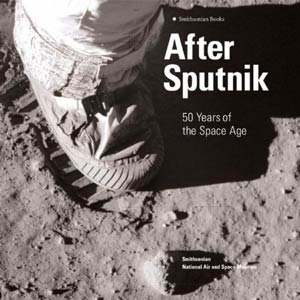|
|
Review: After Sputnik
by Eve Lichtgarn
Monday, April 23, 2007
After Sputnik: Fifty Years of the Space Age
Edited By Martin Collins, Smithsonian National Air and Space Museum
Smithsonian Books, 2007
Hardcover, 256 pp.
ISBN 0-06-089781-3
US $35
Continuing the drum roll of anticipation for the 50th anniversary of Sputnik’s launch this October is another lush literary project from Smithsonian Books, the same publishers as Space 50. (See “Review: Space 50”, The Space Review, April 16, 2007.) This beautiful book originates from the Smithsonian National Air and Space Museum. In celebration of “having lived through five decades of the space age,” the doors are flung open on the cream of the museum’s space collection. The most iconic of the 14,000 rocketry and spaceflight artifacts held in trust by the repository are dramatically photographed and presented in an artful catalog titled After Sputnik: Fifty Years of the Space Age.
This presentation of the curators’ greatest hits embraces items running the gamut from the obvious to the oddball: the V-2 ballistic missile; a tube of Russian sour green cabbage space soup; the dented, bent and beleaguered Vanguard TV3 satellite; a Sputnik music box that plays the “Internationale” punctuated with taunting beeps; the now-infamous Disposable Absorption Containment Trunks, otherwise known as astronaut diapers; Enterprise, the first Space Shuttle; Anita the industrious Skylab 3 spider; John Glenn’s heroic looking spacesuit; a Lunar Roving Vehicle; and a ladies evening handbag in the shape of an Apollo Command Module designed by “Mr. Henry.”
| This presentation of the curators’ greatest hits embraces items running the gamut from the obvious to the oddball. |
The collection is organized chronologically and each decade of the Space Age is preceded by a pithy essay distilling the gist of the given years. All the items selected for this publication are accompanied by a brief explanation of their origin, their significance in space history, and how they were acquired (or “accessioned” in museum parlance) by the museum. Much credit must go to editor Martin Collins and his literary team for appreciating and sharing these macrocosmic and microcosmic distinctions. As an example, the entry of the Gemini 5 mission patch with its “8 Days or Bust” motto seems innocuous, but actually reveals the complicated political, administrative, and public relations tangle that ensnared the naming of missions and mission vehicles. Even the most questionable entry—astronaut Pamela Melroy’s elastic scrunchie used to hold her hair in a ponytail on shuttle missions to the ISS—is imbued with social significance by the vigilant writers. “When women astronauts flew on the Space Shuttle, their longer hair drifted about their heads like halos.” In 1990, NASA issued a hair containment policy, so the scrunchie is “an emblem of small but noticeable changes that occur when women enter a new workplace.”
Giving After Sputnik a distinctive style are the photographs, many of which are credited to Eric Long and Dane Penland. Wherever possible, the artifacts are photographed against black-as-space backgrounds, making everything pop like jewels. Even an Apollo 13 lithium hydroxide canister mock-up of duct tape and plastic hose looks beautiful. The successful merging of these outstanding visuals with the essential text results in what is undoubtedly one of the most desirable publications of this landmark year of our space age.
Eve Lichtgarn is an attorney practicing in the Los Angeles area. She collects artifacts from the early Soviet space program era.
|
|
